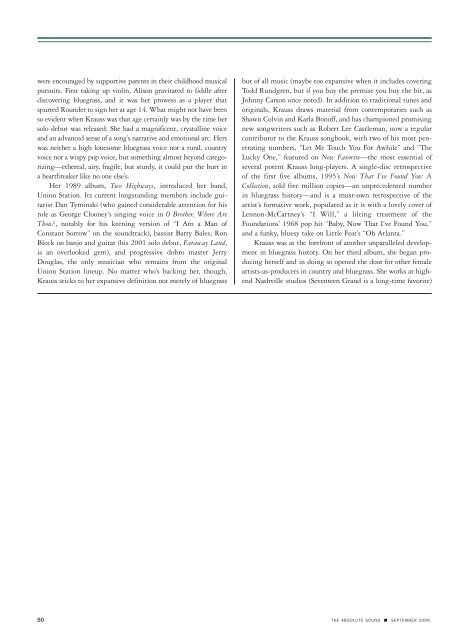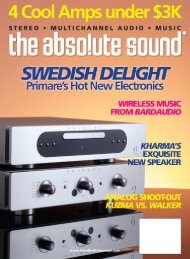The Cutting Edge
The Cutting Edge
The Cutting Edge
Create successful ePaper yourself
Turn your PDF publications into a flip-book with our unique Google optimized e-Paper software.
were encouraged by supportive parents in their childhood musical<br />
pursuits. First taking up violin, Alison gravitated to fiddle after<br />
discovering bluegrass, and it was her prowess as a player that<br />
spurred Rounder to sign her at age 14. What might not have been<br />
so evident when Krauss was that age certainly was by the time her<br />
solo debut was released: She had a magnificent, crystalline voice<br />
and an advanced sense of a song’s narrative and emotional arc. Hers<br />
was neither a high lonesome bluegrass voice nor a rural, country<br />
voice nor a wispy pop voice, but something almost beyond categorizing—ethereal,<br />
airy, fragile, but sturdy, it could put the hurt in<br />
a heartbreaker like no one else’s.<br />
Her 1989 album, Two Highways, introduced her band,<br />
Union Station. Its current longstanding members include guitarist<br />
Dan Tyminski (who gained considerable attention for his<br />
role as George Clooney’s singing voice in O Brother, Where Are<br />
Thou, notably for his keening version of “I Am a Man of<br />
Constant Sorrow” on the soundtrack), bassist Barry Bales, Ron<br />
Block on banjo and guitar (his 2001 solo debut, Faraway Land,<br />
is an overlooked gem), and progressive dobro master Jerry<br />
Douglas, the only musician who remains from the original<br />
Union Station lineup. No matter who’s backing her, though,<br />
Krauss sticks to her expansive definition not merely of bluegrass<br />
but of all music (maybe too expansive when it includes covering<br />
Todd Rundgren, but if you buy the premise you buy the bit, as<br />
Johnny Carson once noted). In addition to traditional tunes and<br />
originals, Krauss draws material from contemporaries such as<br />
Shawn Colvin and Karla Bonoff, and has championed promising<br />
new songwriters such as Robert Lee Castleman, now a regular<br />
contributor to the Krauss songbook, with two of his most penetrating<br />
numbers, “Let Me Touch You For Awhile” and “<strong>The</strong><br />
Lucky One,” featured on New Favorite—the most essential of<br />
several potent Krauss long-players. A single-disc retrospective<br />
of the first five albums, 1995’s Now That I’ve Found You: A<br />
Collection, sold five million copies—an unprecedented number<br />
in bluegrass history—and is a must-own retrospective of the<br />
artist’s formative work, populated as it is with a lovely cover of<br />
Lennon-McCartney’s “I Will,” a lilting treatment of the<br />
Foundations’ 1968 pop hit “Baby, Now That I’ve Found You,”<br />
and a funky, bluesy take on Little Feat’s “Oh Atlanta.”<br />
Krauss was at the forefront of another unparalleled development<br />
in bluegrass history. On her third album, she began producing<br />
herself and in doing so opened the door for other female<br />
artists-as-producers in country and bluegrass. She works at highend<br />
Nashville studios (Seventeen Grand is a long-time favorite)<br />
50 THE ABSOLUTE SOUND ■ SEPTEMBER 2006










